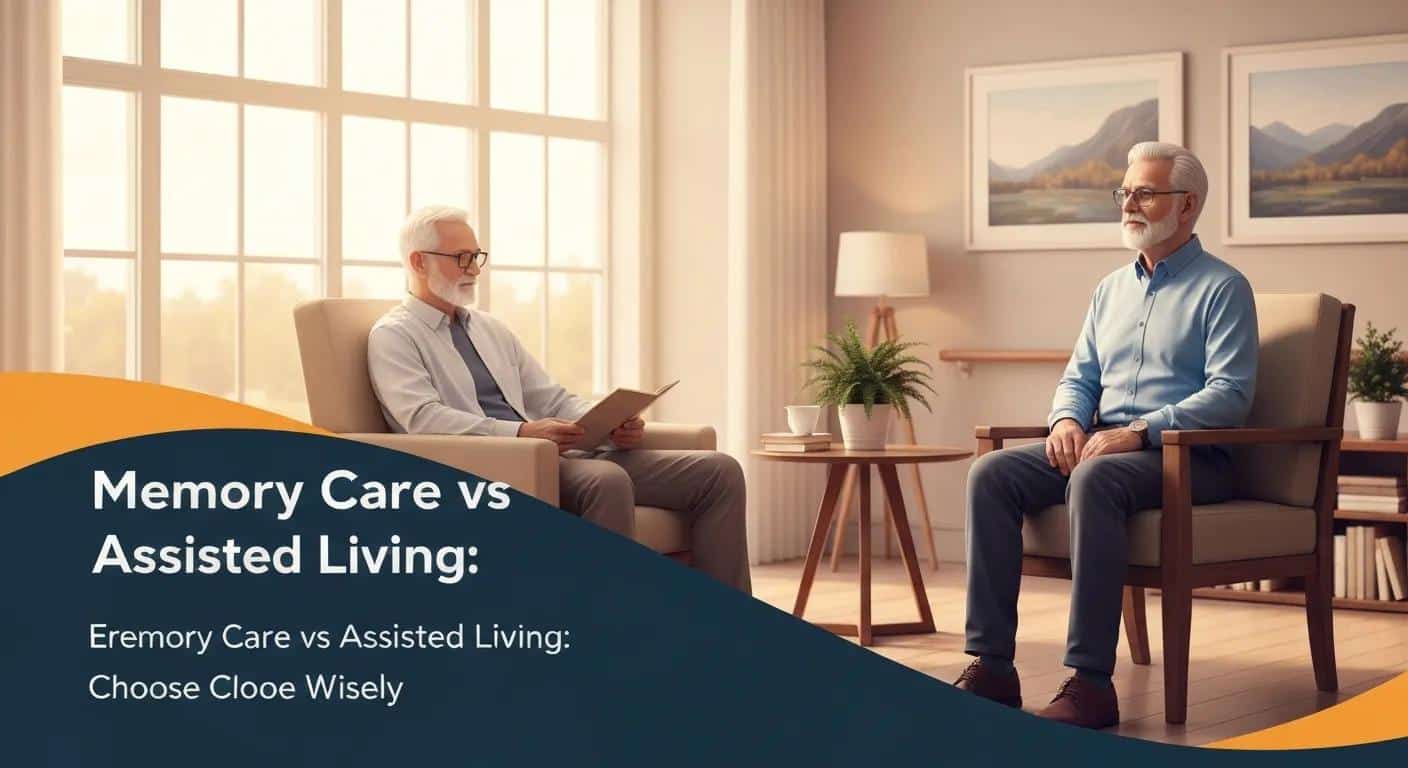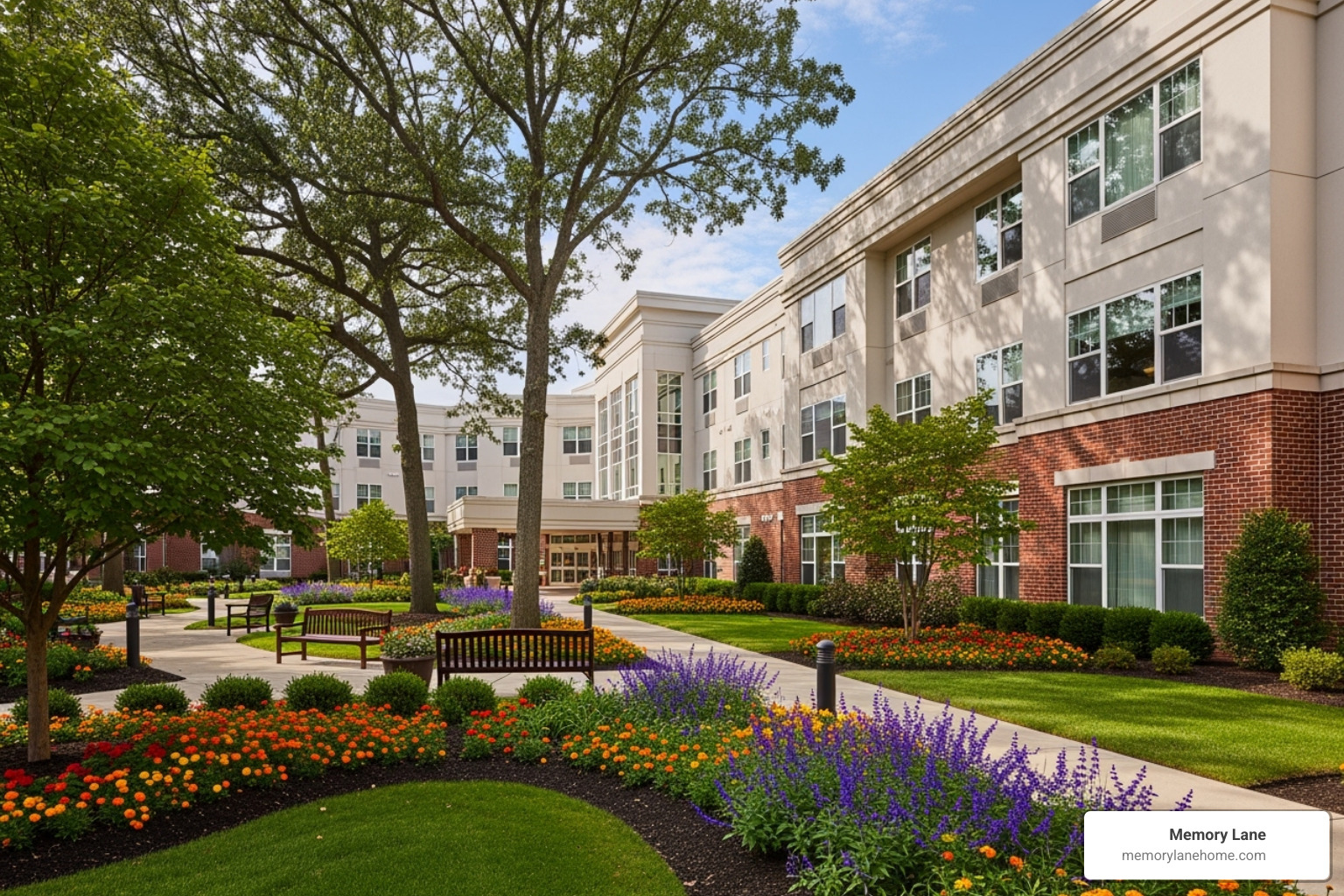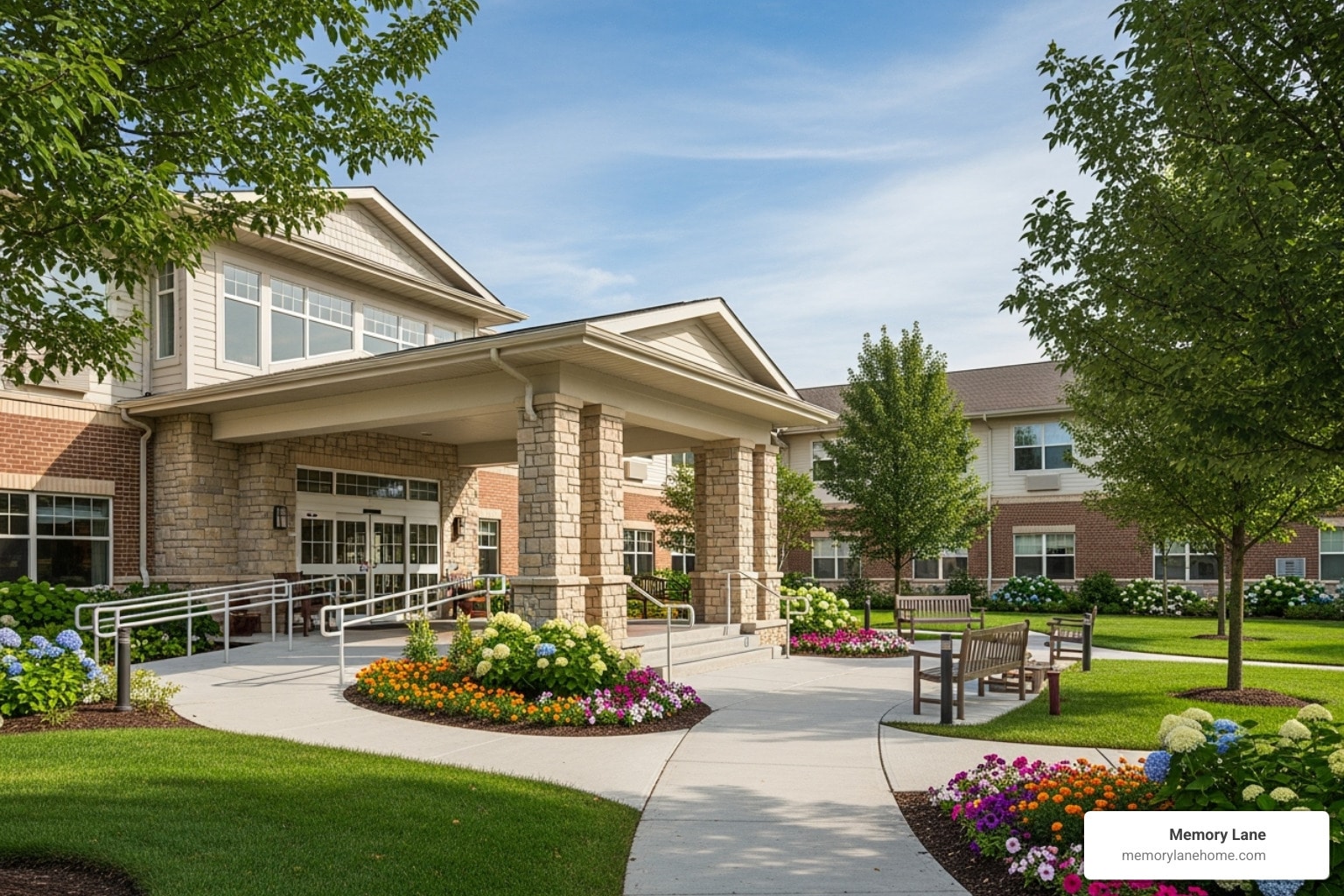Find your perfect Ypsilanti senior housing. Explore assisted living, memory care, and affordable options with our comprehensive guide.

Memory Care vs. Traditional Living: Find Local Facilities
Memory Care vs. Traditional Living: Find Local Facilities

Memory Care Services vs Traditional Assisted Living: What to Choose for Your Loved One in Ann Arbor and Ypsilanti
Every family seeking compassionate support for a loved one with dementia faces a pivotal choice: specialized memory care or traditional assisted living. Memory care facilities near me often promise personalized supervision, secure environments, and tailored activities for individuals with Alzheimer’s disease and other forms of dementia. In contrast, assisted living communities provide broad support with daily living tasks and general social engagement. This guide defines each care type, explores benefits, contrasts environments and costs, outlines decision criteria, and highlights how Memory Lane Assisted Living’s home-like six-bedroom ranch houses in Ypsilanti deliver unmatched peace of mind. By the end, families will clearly understand which option best supports safety, cognitive well-being, and individualized attention.
What Is Memory Care and Who Benefits from Specialized Dementia Support?
Memory care refers to a specialized form of long-term care designed specifically for individuals with memory impairments, such as dementia or Alzheimer’s disease. This type of care typically takes place in a secure, supervised environment that promotes safety while allowing residents to maintain a sense of independence. Memory care facilities feature trained staff who understand the unique challenges faced by those with cognitive impairments, providing tailored support that addresses both emotional and physical needs. Therapeutic activities, social interactions, and a structured daily routine are essential components of memory care, all aimed at enhancing quality of life and encouraging meaningful engagement.
The benefits of specialized dementia support extend to both individuals living with memory impairments and their families. For residents, memory care provides a nurturing atmosphere where they can receive the attention and understanding necessary to thrive, even in the later stages of cognitive decline. Families, on the other hand, gain peace of mind knowing their loved ones are in a secure environment that prioritizes their well-being. Furthermore, the presence of trained professionals allows families to focus on maintaining meaningful relationships rather than managing the day-to-day challenges of care. Ultimately, memory care serves as a crucial resource for individuals and families navigating the complexities of dementia, ensuring that those affected receive compassionate care tailored to their unique needs.
Memory care is a specialized residential program designed to support seniors with Alzheimer’s disease, vascular dementia, Lewy Body dementia, and frontotemporal dementia through enhanced safety measures, cognitive therapies, and therapeutic engagement. This model combines 24/7 supervision with structured routines, secure floor plans, and targeted memory exercises to reduce wandering and confusion. Individuals with moderate to advanced cognitive decline particularly benefit from consistent cues, personalized memory exercises, and compassionate assistance that address progressive symptoms. Understanding how memory care differs from general senior living illuminates why tailored support becomes essential as dementia advances. Exploring foundational definitions leads naturally into specific program features and benefits.
What Is Memory Care for Dementia and Alzheimer’s Disease?
Memory care for dementia and Alzheimer’s disease provides dedicated staff trained in neurological conditions, safety protocols to prevent wandering, and environments that minimize triggers of anxiety. By integrating visual cues, simplified layouts, and purpose-built communal areas, memory care promotes familiarity and reduces disorientation. Caregivers use validated techniques such as reminiscence therapy and errorless learning to reinforce residual skills and support daily functioning. This level of specialized attention improves quality of life by mitigating common dementia challenges like agitation or repetitive behaviors, and it fosters a sense of security for residents and families alike.
How Does Memory Care Address Different Types of Dementia?
Specialized dementia support adapts to distinct symptoms of Alzheimer’s, Lewy Body, and frontotemporal dementia through targeted interventions. In Alzheimer’s care, memory exercises and environmental cues maintain independence for as long as possible. Lewy Body programs emphasize balance support and hallucination management with gentle reassurance and consistent routines. Frontotemporal dementia treatment focuses on behavioral interventions, communication strategies, and small-group activities to reduce impulsivity. Memory Lane Assisted Living tailors activities to each diagnosis, ensuring that individualized care plans reflect the medical and emotional needs specific to each dementia subtype.
What Are the Key Benefits of Memory Care Services?
Before reviewing structured benefits, it is helpful to consider how specialized memory care transforms daily life for residents.
- 24/7 Supervision and Secure Design ensure immediate assistance and prevent dangerous wandering
- Cognitive Stimulation Programs support memory retention and slow cognitive decline
- Social Interaction Opportunities foster community bonds and reduce isolation
- Personalized Therapeutic Activities honor individual preferences and build confidence
- Family Education and Support Services provide guidance for caregivers and strengthen communication
These benefits together create a cohesive environment where residents thrive under constant care, setting the stage to compare traditional assisted living approaches.
How Does Memory Lane’s 24/7 Memory Care Staffing Ratio Enhance Resident Safety?
Memory Lane Assisted Living maintains a 1:3 caregiver-to-resident ratio during daytime hours and a 1:6 ratio at night, significantly exceeding typical industry standards. This elevated staffing ensures rapid response to emergencies, continuous monitoring for wandering risks, and frequent personalized interactions that reinforce routines. Higher staffing levels also promote proactive engagement, reducing the likelihood of fall incidents and behavioral escalations. Families gain confidence knowing every resident receives focused attention, which reinforces a secure atmosphere essential for individuals with evolving memory challenges.
What Is Traditional Assisted Living and Who Is It Best Suited For?
Traditional assisted living is a residential model that provides support with activities of daily living (ADLs) such as bathing, dressing, medication management, and meal assistance within a community setting. Residents enjoy private or shared apartments, communal dining, scheduled social events, and general wellness programs without specialized dementia protocols. This format suits seniors who value autonomy, socialization, and light assistance but retain much of their cognitive and physical independence. Recognizing its scope clarifies why assisted living fits certain needs and when higher-level memory care becomes necessary.
What Services and Amenities Are Offered in Assisted Living?
Assisted living communities typically offer a range of supportive services and amenities, including:
- Assistance with Activities of Daily Living such as toileting, dressing, and grooming
- Medication Reminders and Administration by licensed staff
- Scheduled Social and Recreational Activities to promote engagement
- Housekeeping, Laundry, and Maintenance for apartment care
- Dining Programs with nutritious, restaurant-style meals and flexible dining times
These offerings foster independence while providing essential support, preparing readers to consider who benefits most from this care model.
Who Typically Benefits from Assisted Living Care?
Seniors experiencing mild mobility limitations, early stages of cognitive decline, or temporary recovery needs benefit most from assisted living. Individuals who still recognize family and surroundings, engage in basic self-care, and enjoy social activities find the balance of freedom and assistance ideal. Assisted living supports those with stable health conditions who require minimal memory cues and preventive wellness monitoring. Understanding this balance sets the stage for identifying cases when memory care offers critical added value.
When Is Assisted Living Not Enough for Dementia Care?
Assisted living may fall short when residents exhibit increasing confusion, frequent wandering, aggressive behaviors, or significant memory loss that risks personal safety. Signs such as repeated falls, medication mismanagement, or inability to follow simple routines indicate progression toward moderate or advanced dementia. At this point, families need secure entry points, locked perimeters, and staff trained in de-escalation and cognitive therapies. Recognizing these red flags guides families toward the more specialized environment of memory care.
What Are the Key Differences Between Memory Care and Assisted Living?
Memory care and assisted living differ across environment design, staff expertise, engagement programs, and cost structures, with each dimension shaping resident experience. Memory care homes use secure floor plans, dementia-trained staff, and cognitive support programs, while assisted living emphasizes general support and social activities. Comparing caregiver ratios, training requirements, activity scope, and pricing reveals how specialized services align with higher costs. A side-by-side analysis elucidates which features matter most for families facing dementia challenges.
How Do Environment and Security Differ in Memory Care vs Assisted Living?
Memory care communities feature locked entry systems, enclosed courtyards, and simplified layouts to minimize confusion and wandering risks. Private rooms often include memory cues like familiar décor and personalized signage. Assisted living buildings provide open common areas, multiple entrances, and standard apartment corridors that lack specialized safety features. The contrast underscores why memory care environments offer enhanced protection for residents with impaired spatial awareness, while assisted living suites prioritize accessibility over security.
What Are the Differences in Staff Training and Caregiver-to-Resident Ratios?
Staff in memory care undergo specialized dementia certification programs, behavioral management training, and ongoing education in neurological conditions. Memory Lane’s 1:3 daytime and 1:6 nighttime staffing ratios ensure each resident receives ample one-on-one support. Assisted living staff typically maintain ratios of 1:8 to 1:15 during the day and receive general caregiving training without dementia-specific modules. These distinctions translate into faster response times, deeper understanding of memory loss behaviors, and more consistent reinforcement of therapeutic activities.
How Do Activities and Engagement Vary Between the Two Care Types?
Activity programs in assisted living revolve around general fitness classes, social gatherings, arts and crafts, and outings that suit independent seniors. In memory care, structured cognitive sessions, personalized reminiscence therapy, sensory stimulation exercises, and small-group memory circles address specific neurological needs.
What Are the Cost Differences Between Memory Care and Assisted Living in Michigan?
Families considering care in Michigan encounter average monthly costs of approximately $5,700 for assisted living and $7,800 for memory care in 2025. Memory care typically runs 25 percent higher due to specialized staff training, secured facilities, and cognitive programming.
Transparent cost comparisons help families align budgets with levels of care necessary for safety and well-being.
Memory Care vs. Assisted Living: Impact on Nursing Home Admissions for Dementia Patients
The exposure of interest was change of residence to a memory-care assisted living, compared to an assisted-living community without a specialized license. We defined memory care assisted living as assisted living facilities that have a specialized license to provide memory care services. The purpose of this study was to examine the association between memory care assisted living and nursing home admissions among assisted-living residents with dementia.
Memory care reduces nursing home admissions among assisted‐living residents with dementia, W Zhang, 2022
When Should Families Choose Memory Care Over Assisted Living?
Choosing memory care over assisted living becomes essential when dementia progression jeopardizes safety, routine stability, or emotional health. Critical indicators include increased wandering, inability to perform daily tasks, or behavioral changes requiring specialized management. Transitioning proactively prevents crisis situations and ensures continuity of compassionate support. Understanding these triggers empowers families to act before safety emergencies compel hurried moves.
What Are the Signs That Indicate a Need for Memory Care?
- Frequent Wandering or Getting Lost within familiar buildings
- Escalating Aggression or Agitation without clear triggers
- Progressive Cognitive Decline marked by inability to recall close family names
- Repeated Falls or Inconsistencies in Basic Self-Care
- Difficulty Following Simple Instructions that disrupts daily life
How Do Safety Concerns Influence the Transition to Memory Care?
Safety considerations such as unlocked exits, uncontrolled medication access, and unsupervised bathing present real hazards as dementia advances. Memory care facilities incorporate monitored door alarms, medication dispensing systems, and round-the-clock supervision to mitigate these risks. Prioritizing environments with specialized safety features reduces accidents, decreases emergency hospital visits, and promotes calmer daily routines for residents and families alike.
Why Is Specialized Support Critical for Advanced Dementia?
Advanced dementia brings complex behavioral symptoms, fluctuating mood states, and increasing need for assistance with basic tasks. Specialized support integrates personalized care plans, evidence-based therapies, and ongoing cognitive stimulation to maintain dignity and quality of life. Memory Lane Assisted Living’s therapeutic activities and individualized routines promote meaning and structure at every stage, ensuring that residents receive both emotional and medical support essential for advanced memory loss.
How Does Memory Lane Assisted Living Provide a Unique Home-Like Memory Care Environment?
Memory Lane Assisted Living’s distinctive model operates within three six-bedroom ranch houses—Merritt, Carpenter, and Stoneham—designed to feel like private homes rather than institutional facilities. Each house embodies a small-group residential setting with cozy porches, shared dining rooms, and landscaped lawns that foster familiarity. Personalized décor, family-style meal times, and communal living areas evoke long-standing traditions, gently easing residents into supportive routines. This residential approach transforms memory care into an intimate experience where genuine community bonds flourish.
What Are the Features of Memory Lane’s Six-Bedroom Ranch Houses?
The six-bedroom ranch houses include:
- Private Bedrooms with Personalized Artwork and Memory Cues
- Shared Dining Rooms for Family-Style Meal Service
- Comfortable Living Areas with Familiar Furniture Arrangements
- Secured Outdoor Patios and Enclosed Courtyards for Safe Exploration
- Robust Safety Features such as Visual Wayfinding and Door Alarms
How Does a Home-Like Setting Benefit Residents with Dementia?
A home-like atmosphere fosters familiarity, lowers anxiety, and strengthens memory through consistent environmental cues. Décor reminiscent of past family residences triggers positive associations that enhance orientation and comfort. Smaller household sizes enable personalized relationships with caregivers, encouraging trust and emotional security. This setting supports daily rituals that residents recognize, promoting independence and minimizing disorientation compared to larger institutional layouts.
What Personalized Dementia Care Plans Does Memory Lane Offer?
Each resident receives an individualized care plan based on cognitive assessments, personal history, and family preferences. Plans incorporate therapeutic schedules, favorite pastimes, music, and reminiscence activities tied to meaningful life events. Regular reviews adjust goals, introduce new memory games, and integrate emerging interests to maintain engagement. By honoring unique preferences and life stories, Memory Lane sustains personalized connections that improve mood, memory retention, and overall well-being.
How Does Memory Lane’s High Caregiver-to-Resident Ratio Improve Care Quality?
Maintaining a 1:3 daytime and 1:6 nighttime staff ratio ensures caregivers have time for meaningful interactions, prompt assistance, and proactive monitoring. This level of attention allows tailored responses to behavioral changes, immediate intervention in safety incidents, and consistent reinforcement of familiar routines. The high ratio also supports family communication, enabling detailed updates and collaborative goal setting. Superior staffing underpins the compassionate, individualized care that differentiates Memory Lane’s memory care homes.
What Does Memory Lane’s All-Inclusive Pricing Cover?
Transparent all-inclusive pricing simplifies financial planning and encompasses every essential service:
This comprehensive model eliminates surprise charges and aligns care quality with budgeting ease.
What Do Families Say About Choosing Memory Lane for Memory Care?
Families describe Memory Lane Assisted Living as a trust-building partner in the dementia care journey, emphasizing compassionate staff, personalized attention, and seamless communication. Testimonials frequently highlight relief from safety concerns, noticeable improvements in loved ones’ engagement, and consistent updates about daily programs. These success stories underscore an environment where families feel supported and residents thrive under attentive guidance. Gathering themes from these reflections offers insight into the meaningful impact of specialized memory care delivered in a home-like community.
What Are Common Themes in Family Testimonials and Success Stories?
Family stories often revolve around shared trust, improved quality of life, and restored hope:
- Compassionate Caregivers Who Know Each Resident’s History and Preferences
- Consistent Communication That Keeps Families Informed and Involved
- Enhanced Resident Engagement Through Tailored Activities and Social Bonds
- Noticeable Reductions in Wandering and Agitation—Leading to Calm and Predictability
- Transparent Pricing That Removes Financial Worries
How Does Memory Lane Support Families Through the Care Journey?
Memory Lane’s approach extends support beyond resident care by offering family education sessions, resource referrals, and ongoing consultations. Care coordinators provide guidance on dementia progression, coping strategies, and community resources that enhance at-home connections. Regular family meetings review care plan updates and invite feedback, fostering collaboration and trust. This comprehensive support network empowers families to remain active participants in their loved one’s care, reinforcing continuity between home and residential settings.
How Can Families Make the Right Choice Between Memory Care and Assisted Living?
Making an informed care decision involves assessing cognitive needs, safety requirements, budget constraints, and personal preferences. Families should employ standardized assessment tools, weigh key factors, and engage facility tours to gather firsthand impressions. A structured decision framework clarifies options and ensures that every consideration—from cost transparency to home-like settings—aligns with the resident’s evolving needs. This practical guide equips families with actionable steps to select the best care environment for their loved one.
What Assessment Tools Help Determine the Best Care Option?
Objective evaluations provide clarity, such as:
- Standardized Cognitive Tests measuring memory, orientation, and executive function
- Safety Evaluations assessing fall risk, wandering tendencies, and medication management capabilities
- ADL Checklists rating independence in dressing, bathing, and eating
- Behavioral Inventories tracking agitation, aggression, or mood fluctuations
- Professional Recommendations from neurologists, geriatricians, and social workers
What Factors Should Families Consider When Choosing Care?
Families should evaluate multiple dimensions, including:
- Level of Supervision required for memory or mobility challenges
- Staff Expertise and Caregiver-to-Resident Ratios for personalized support
- Environment Design balancing safety, familiarity, and social engagement
- Cost Structure and Transparency to align with financial planning
- Location Proximity to family for regular visits and community ties
How Can Families Schedule a Tour or Consultation at Memory Lane?
To explore Memory Lane Assisted Living’s home-like memory care ranch houses, families can contact the care coordination team for a personalized consultation. Tours include a guided walkthrough of Merritt, Carpenter, and Stoneham Houses, discussions of individualized care plans, and transparent pricing reviews. This introductory visit helps families experience the intimate environment, meet specialized dementia caregivers, and ask detailed questions about programs and services. Taking this next step provides firsthand assurance that loved ones will receive compassionate, specialized support.
Choosing the right care setting can profoundly influence quality of life for seniors with memory challenges. By comparing memory care and traditional assisted living across environment, staffing, programming, and cost, families gain clarity on ideal support levels. Memory Lane Assisted Living’s intimate six-bedroom ranch houses deliver tailored dementia care, robust safety features, and all-inclusive pricing that removes financial uncertainty. With comprehensive assessment tools and transparent tours, families can confidently select the environment that promotes security, engagement, and personalized attention for their loved one.
Frequently Asked Questions
What is the difference in cost between memory care and assisted living?
In Michigan, the average monthly cost for assisted living is approximately $5,700, while memory care typically costs around $7,800. The higher price for memory care reflects the specialized staff training, secured facilities, and tailored cognitive programming designed to meet the unique needs of residents with dementia. Understanding these cost differences is crucial for families when budgeting for long-term care options.
How can families assess the level of care needed for their loved ones?
Families can utilize various assessment tools to determine the appropriate level of care. Standardized cognitive tests can measure memory and orientation, while safety evaluations assess fall risks and wandering tendencies. Additionally, ADL checklists can help gauge independence in daily activities. Consulting with healthcare professionals, such as neurologists or geriatricians, can also provide valuable insights into the necessary care level for individuals experiencing cognitive decline.
What role do family members play in the care process at memory care facilities?
Family members play a vital role in the care process at memory care facilities by participating in regular meetings to discuss care plans and provide feedback. They are encouraged to engage in family education sessions that offer resources and coping strategies for dementia. This collaboration fosters trust and ensures that families remain active participants in their loved one’s care, enhancing the overall support system for residents.
What types of activities are typically offered in memory care facilities?
Memory care facilities offer a variety of activities tailored to the cognitive and emotional needs of residents. These may include structured cognitive sessions, reminiscence therapy, sensory stimulation exercises, and small-group memory circles. Activities are designed to promote engagement, enhance memory retention, and provide social interaction, all of which are essential for improving the quality of life for individuals with dementia.
How does a home-like environment benefit residents with dementia?
A home-like environment significantly benefits residents with dementia by fostering familiarity and reducing anxiety. Features such as personalized décor and smaller household sizes create a sense of comfort and security. This setting encourages trust between residents and caregivers, promotes daily rituals, and minimizes disorientation, ultimately enhancing the overall well-being of individuals living with memory challenges.
What should families look for when touring memory care facilities?
When touring memory care facilities, families should observe the environment, focusing on safety features, staff interactions, and the overall atmosphere. It’s important to inquire about caregiver-to-resident ratios, staff training in dementia care, and the types of activities offered. Additionally, families should assess how well the facility promotes a sense of community and whether it aligns with their loved one’s needs and preferences.
How can families ensure their loved ones receive personalized care in memory care settings?
To ensure personalized care in memory care settings, families should advocate for individualized care plans that reflect their loved one’s history, preferences, and cognitive assessments. Regular communication with caregivers and participation in care plan reviews can help adjust activities and goals as needed. By fostering a collaborative relationship with the care team, families can enhance the quality of care and support their loved one’s unique needs.
Conclusion
Choosing the right care setting can profoundly influence quality of life for seniors with memory challenges. By comparing memory care and traditional assisted living across environment, staffing, programming, and cost, families gain clarity on ideal support levels. Memory Lane Assisted Living’s intimate six-bedroom ranch houses deliver tailored dementia care, robust safety features, and all-inclusive pricing that removes financial uncertainty. With comprehensive assessment tools and transparent tours, families can confidently select the environment that promotes security, engagement, and personalized attention for their loved one.


